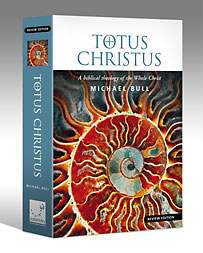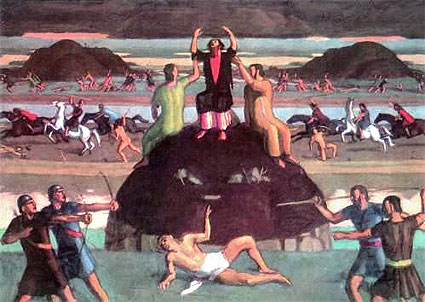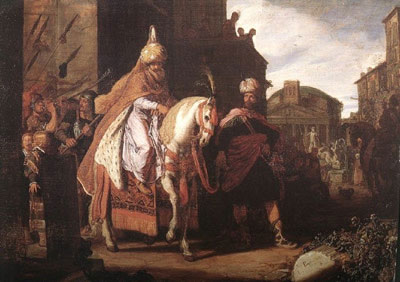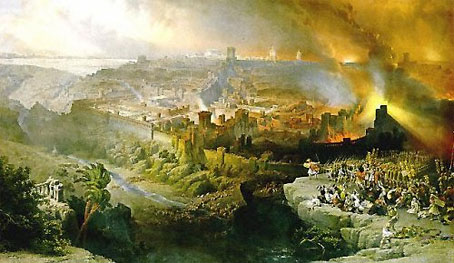Apr
10
2009
 “I have not come to bring peace, but a sword.” (Matthew 10:34)
“I have not come to bring peace, but a sword.” (Matthew 10:34)
Whenever the Word of God comes, it is an end to business as usual. Some people taste life, others taste death, and there is conflict between the quick and the dead. God sends confusion to those who have chosen death, and gives miraculous persevering strength to those who have chosen life. Eventually, the wicked are judged and the redeemed are gathered around God. God lets His Word loose among us to create new life, thresh out the husks and gather the wheat into His barn. He calls the sheep out from the goats and brings them home. He disturbs us to bring us true rest.
Jesus’ parables were a two-edged sword. They forced the believers to wrestle with spiritual truths. They also confused and incited the unbelievers to a showdown that would expose their true natures and hasten their destruction. The Bible is the same. It is living water or a cup of destruction depending upon who is drinking.
Comments Off | tags: Parables, Power of the Gospel | posted in Biblical Theology, Totus Christus
Apr
10
2009
 “And now, indeed, the hand of the Lord is upon you, and you shall be blind, not seeing the sun for a time.” And immediately a dark mist fell on him, and he went around seeking someone to lead him by the hand.” Acts 13:11
“And now, indeed, the hand of the Lord is upon you, and you shall be blind, not seeing the sun for a time.” And immediately a dark mist fell on him, and he went around seeking someone to lead him by the hand.” Acts 13:11
The blindness of Elymas caused Sergius Paulus to believe. The temporary blindness of a Jew brought about the conversion of a Gentile.
A repeated symbolic concept in Scripture is that of sight and blindness. Samson and King Zedekiah both lost their eyes. Isaac and Eli were blind. From Genesis 1:4, 3:6 and 6:2 we learn that eyes are organs of discernment and judgment. The process of maturity makes wise judges who are “the eyes of the Lord”, walking “to and fro on the earth”, collecting evidence to present before His court. Bible symbols are consistent, and their meanings become plain to the saints with their “new eyes.” Those who refused to obey the gospel twisted the Scriptures to their own destruction (2 Peter 3:16).
“For I do not desire, brethren, that you should be ignorant of this mystery, lest you should be wise in your own opinion, that blindness [hardness] in part has happened to Israel until the fullness of the Gentiles has come in.” Romans 11:25
…Herod and the Jews had symbolically become Egypt, hardened like Pharaoh (Romans 9:17-18; Hebrews 3:16; 8:9; 11:26-29; Jude 1:5; Revelation 11:8). The old Jerusalem was Hagar, and the New Jerusalem was Sarah. Christians, not Jews, were “the promised child.” Judaism had become childless like Naomi, and it was only the “fullness” of outsiders, Peter’s “unclean animals”—Ruth—that rescued the people of God from spiritual famine, the extinction of unbelief. The barrenness of Egypt was replaced with the harvest of Pentecost.
…Agabus the prophet foretold a famine in Judea (the curse for the shedding of Stephen’s innocent blood), but the Antioch saints sent relief (the richness of ‘Ruth’) to those in Judea.
Comments Off | tags: Acts, Isaac, Paul, Ruth, Samson, Typology, Zedekiah | posted in Biblical Theology, The Last Days, Totus Christus
Apr
10
2009
Attack from the Abyss

As with most things in the Bible the pattern begins in Genesis.
Unlike the serpent’s warriors, who live by the sword, God’s warrior is a father-ruler who fights only to protect those in his care. Nimrod was a serpent-king—a dragon; Abram was a servant-king, God’s answer to Nimrod the ‘rebel’ (most likely Gilgamesh).
Satan’s attack on ‘the offspring of the woman’ through Pharaoh had failed, so he resorted to inciting a conspiracy of nations. The serpent became a dragon. But Abram (as a good Gilgamesh/Nimrod), along with the men of his household, defeated them, rescued Lot and his family, and very importantly, plundered the attackers. The darkest nights that God allows are always opportunities for more glory. And, this being HOLY war, Abram refused the ‘devoted’ plunder.
The next instance involves Amalek, who attacked Israel in the wilderness, and mercilessly picked off the stragglers. Once again, God’s man “came down” to fight – in Joshua, at Moses’ command – with Moses, Hur and Aaron as Ark and cherubim on the holy hill, the “garden gate”.
“The Lord will have war with Amalek from generation to generation.” (Exodus 17:16)
This statement about Amalek is more loaded than it seems. Amalek was defeated, and the plunders from the victory were devoted to building God’s house in the wilderness. We will see this pattern again and again. Each time, deliverance for God’s people is on a greater scale, and the defeat more catastrophic for His enemies.
Comments Off | tags: Aaron, Abraham, Amalek, Genesis, Holy war, Moses, Nimrod, Pharaoh, Tabernacle | posted in Against Hyperpreterism, Biblical Theology, The Last Days, Totus Christus
Apr
10
2009
Saul and Agag
 I puzzled over Ezekiel chapters 38 and 39 for years. Bible commentators suggested many things but nothing seemed to fit the historical context of the surrounding chapters. It seems James B. Jordan was the first to put the pieces together.1
I puzzled over Ezekiel chapters 38 and 39 for years. Bible commentators suggested many things but nothing seemed to fit the historical context of the surrounding chapters. It seems James B. Jordan was the first to put the pieces together.1
Continue reading
Comments Off | tags: Amalek, Atonement, Babylon, Bible history, Esther, Ezekiel, Gary DeMar, Haman, James Jordan, Mordecai, Saul, Typology | posted in Against Hyperpreterism, Biblical Theology, The Last Days, Totus Christus
Apr
10
2009
Counterfeit Kingdom Come
Then the dragon became furious with the woman and went off to make war on the rest of her offspring, on those who keep the commandments of God and hold to the testimony of Jesus. And he stood on the sand of the Sea. Revelation 12:17 [ESV]

“After a number of years of peace for the Church (Acts 9:31), Wormwood poured out his poisonous waters, false Judaising doctrines, to try and corrupt the woman. God raised up Paul to defeat Satan and the Judaisers, and meanwhile the land (the Circumcision) drank up his false doctrine. Satan has engaged in two tactics: persecution and corruption. These have failed. So now he decides to return to persecution, but this time against the non-Jewish believers, the “rest of her offspring”. He stands on the sands of the sea, addressing the Roman Gentile sea, and raises up the Sea Beast.”1
Continue reading
Comments Off | tags: Amalek, Compromise, Daniel, Haman, James Jordan, Nebuchadnezzar, Paul, Revelation, Satan, Totus Christus | posted in Against Hyperpreterism, Biblical Theology, The Last Days, Totus Christus
Apr
10
2009
 David Field1 says the Totus Christus, the Whole Christ, is “one and many in federal union = in covenantal oneness.” It is Jesus as head and the church as His body.
David Field1 says the Totus Christus, the Whole Christ, is “one and many in federal union = in covenantal oneness.” It is Jesus as head and the church as His body.
Whenever God does something in redemptive history, the Devil produces a counterfeit. Something I have just noticed about the Revelation is another aspect to this ‘evil twin’ pattern. It is a counterfeit Totus Christus.
After the ascension of Christ, Satan was thrown down from heaven to the Land, and took up residence in Herod’s Temple as Jesus predicted (Matthew 12:45). (Notice that Jesus’ ministry as Adam was heaven-garden-heaven, and Satan’s counterfeit usurping was thus garden-heaven-garden.)
Revelation then moves into a description of two warring armies, the saints with lion faces, and the ‘bad Nazirites.’ The Jews and Judaisers as Jezebel, the false church, are finally destroyed; the true church is massacred but ascends to be with Christ “in the air.”
So the church is Christ’s permanent body. Satan’s brief possession of Judah (Land Beast/False Prophet) and Rome (Sea Beast) was the Totus Diabolus in the Land. He will not be able to do such again until he is released for a short season at the end of World history.
I guess this also means that, in response to the marriage supper of the Lamb, and the faithfulness of Christ to His bride, the best Satan could manage was a one night stand.
1 http://davidpfield.blogspot.com/2006/10/totus-christus.html
Comments Off | tags: David Field, In the air, Jezebel, Nazirite, Satan | posted in Biblical Theology, The Last Days, Totus Christus
Apr
10
2009
Counter-FEET
The gospel was on its way to conquering the Roman empire. Jewish persecution had failed (read Acts). A flood of false doctrine had failed (read the later epistles for the fight). So Satan used persecution from a Jew-Gentile conspiracy to persecute the new church.
The thought is this:
The feet of the statue in Daniel 2 became Satan’s answer to the by-now successful “intermarriage” of Jews and Gentiles in one body, the Christian church. As a Jew-Gentile conspiracy, the metal man became an evil twin of Paul’s Jew-Gentile Tabernacle. With unclean feet of Roman iron intermarried with Edomite (red) clay, Judaism became the church of Esau.
(For more, see Esau’s Ladder).
Comments Off | tags: Compromise, Daniel, Genesis, Satan | posted in Biblical Theology, The Last Days, Totus Christus
Apr
10
2009
The Bible contains some patterns that are frequently repeated. Sometimes these are inverted or reversed to make a point.
An example would be the seven feasts listed in Leviticus 23 which provide a common literary structure. Revelation 1-11 follows this heptamerous pattern, with Jesus’ ascension in 4-5 as Firstfruits. Revelation 12-19 also follows this pattern, with the rise of the false prophet and harlot as an ironic counterfeit of Firstfruits.
In Revelation 16, in the second major cycle, the “Ascension” section concerns the fall of Babylon and its internal structure is upside down to make the point. Reaching the end of this second cycle, the “Atonement” section is even more tricksy. Because the seven feasts are chiastic (symmetrical) with Pentecost at the centre (actually the scorching fire of un-Pentecost), Passover (Red Sea) and Atonement (Jordan) correspond (feast 2 and feast 6). So even though the seven bowls deconstruct the Old Covenant feasts – running through their order backwards – the “un-Passover” of bowl 6 is actually the “Atonement” Joshua-conquest of the church, the new Israel. So this bowls section is a subtle see-saw, working from 7 down to 1 for the Old Covenant, and from 1 to 7 for the New. This becomes apparent at bowl 6, when, at Un-Passover, (the new church’s day of covering) old Israel is exposed, uncovered, before God.
Amazing.
Comments Off | tags: Atonement, Feasts, Leviticus, Passover, Revelation, Typology, Un-Passover | posted in Biblical Theology, The Last Days, Totus Christus
Apr
10
2009
 For the ancient world, a garden, a house, a city or a temple was like a woman. An invading army, after storming through the gates of a city, would rape the virgins. It was a brutal reminder that, like the women, the conquered city was not impregnable.
For the ancient world, a garden, a house, a city or a temple was like a woman. An invading army, after storming through the gates of a city, would rape the virgins. It was a brutal reminder that, like the women, the conquered city was not impregnable.
“In order to understand this, we have to think like ancient Hebrews, and not like modern people… Adam was supposed to guard the garden, and he was also supposed to guard his wife.
The Song of Solomon compares the woman to a garden several times in the course of the book. In all languages, the words for city, garden, and the like are feminine, and we speak of a city as “she” in English today.
Let us take a look at the city in the Bible, remembering that what is said of the city is also true of the house, tent, Temple, Tabernacle, and other enclosed homes for humanity. The city has walls and gates. The purpose of these walls and gates is to keep the enemy out. The goal is that the city be impregnable, and note that English word – it directly connects the city with the woman. Thus, the city has to be a virgin, sealed against attack. Jerusalem is referred to as an impregnable virgin repeatedly in Scripture (2 Kings 19:21; Is. 37:22; Jer. 14:17; 18:13; Jer. 31:21; Amos 5:2). The attack on Jerusalem is thus the rape of a city (Lam. 1:15; 2:13)… Just as Eve was “built” from Adam (using an architectural term, Gen. 2:22), so Jerusalem would be rebuilt as a virgin (Jer. 31:4)… Thus, the safety and security of the virgin daughters of Israel was a symbol of the safety and security of the whole land. Their inviolability corresponded to the inviolability of the whole culture (Lam. 1:4; 2:10).”
In the case of Babylon, its walls and gates were impregnable. The city was built on the Euphrates river, which ebbed into the city under the wall. Even the banks of the river were protected by metal gates from any invaders who could hold their breath long enough. Under Belshazzar, Babylon lost her virginity (Isaiah 47:1-3), and during the feast her river gates had been left open.
In a brilliant military manoeuvre, Cyrus the Great gave the signal for his troops upstream to divert the river. The invading army marched into the city dryshod and took it with little resistance. There were hints of this in the prophecies of both Isaiah (44:27) and Jeremiah (50:38, 51:36). The waters of the bringer of the “flood” were dried up. The Land was rising from the deep.
___________________
James B. Jordan (concerning the virginity of Jephthah’s daughter), Judges: God’s War Against Humanism, p. 211-212. Download from www.biblicalhorizons.com
Comments Off | tags: Babylon, Belshazzar, Cyrus, Greater Eve, James Jordan, Judges | posted in Biblical Theology, The Restoration Era, Totus Christus
Apr
10
2009
“Then the sixth angel blew his trumpet, and I heard a voice from the four horns of the golden altar before God, saying to the sixth angel who had the trumpet, “Release the four angels who are bound at the great river Euphrates.” Revelation 9:13-14
To purify the Land of the sins of the nation or the High Priest, the horns of the Incense Altar were smeared with blood from the sacrifice at the bronze Altar. These four angelic commanders, who were previously held back, were horns looking for blood.*
The fifth trumpet, alluding to Joel 2, had summoned clouds of Babylonian locusts (Judaisers) with hair like women (false Nazirites) from Herod’s false altar to devour the Land. Like those in Joel, these are ‘mighty men,’ the result of the compromise of the sons of God with idolatry (Genesis 6).
Now, the sixth trumpet brought a response from the true Altar of Incense—an unimaginable cloud of true Nazirites. The position of this event in the structure of the passage alludes to Joshua’s conquest of Canaan. But as a ‘Trumpet’, this was only a warning. The sixth bowl would bring the final conquest: Armageddon.
The sixth angel poured out his bowl on the great river Euphrates, and its water was dried up, to prepare the way for the kings from the sunrise.
Like the Jews returning from Babylon, and Abraham when he first entered Canaan, they crossed the great river Euphrates in their baptism into Christ. Just as Cyrus “parted” the Great River to conquer Babylon, the river of death was parted to allow the true saints to inherit the heavenly country. Old Jerusalem became Jericho – the city devoted to destruction.
This was an army of true Nazirites who had not broken their vow:
These are the ones who were not defiled with women, for they are virgins. These are the ones who follow the Lamb wherever He goes. These were redeemed from among men, being firstfruits to God and to the Lamb. (Revelation 14:4)
Instead of storming the open gates and raping the virgins, here an army of “virgins” crossed the Euphrates, stormed into Babylon and purified the daughters of men culture around them.
(*This refers to the Hebrew for corners and commanders being the same word.)
Comments Off | tags: Babylon, High Priest, Incense Altar, Joshua, Nazirite, Revelation | posted in Biblical Theology, The Last Days, Totus Christus
 “I have not come to bring peace, but a sword.” (Matthew 10:34)
“I have not come to bring peace, but a sword.” (Matthew 10:34)





























